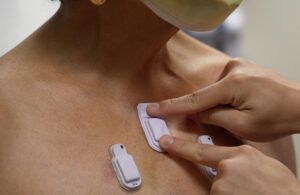Summary:
Northwestern University researchers have developed a noninvasive, continuous monitoring wearable that offer a dynamic assessment of lung health and other physiological functions, With potential applications in both adult and infant care settings.
The wearable device continuously monitor the sounds produced by a patient’s body, including breathing, heartbeats, and digestion. These soft devices adhere to the patient’s skin and use two high-performance digital microphones—one facing inside the patient and the other facing outward. An algorithm then separates internal and external sounds, even correcting for ambient noise in noisy environments like hospitals.
The wireless, wearable devices are compact, encapsulated in soft silicone, and equipped with components such as a flash memory drive, battery, Bluetooth, accelerometers, and miniaturized microphones.
The technology was clinically tested on 55 adult subjects, including 20 with chronic lung diseases, and 15 premature babies with respiratory and intestinal motility disorders. These devices are positioned on babies below the suprasternal notch, on the right and left chest, or on the abdomen to monitor various physiological aspects. They can map the flow of air in and out of the lungs, assess cardiac rhythm changes, and track the movement of food, gas, and fluids through the intestines. The devices also record ambient noise levels around babies, providing opportunities to address potential sources of stress. Allowing continuous real-time monitoring to assess lung health and personalize treatments.
Article written by Medical Design
20/11/2023
Source:
Medical Design
https://www.medicaldesignandoutsourcing.com/first-wearable-device-continuous-body-sounds-monitoring/

